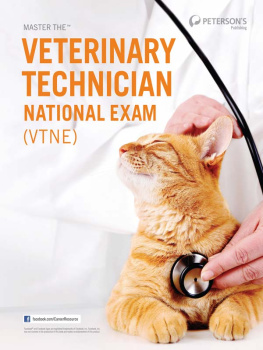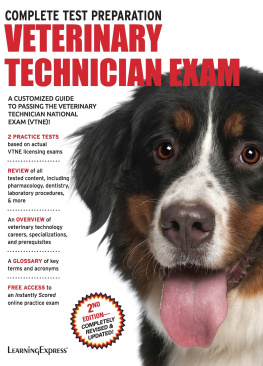Mometrix Veterinary Certification Test Team - VTNE Flashcard Study System: VTNE Test Practice Questions & Review for the Veterinary Technician National Exam
Here you can read online Mometrix Veterinary Certification Test Team - VTNE Flashcard Study System: VTNE Test Practice Questions & Review for the Veterinary Technician National Exam full text of the book (entire story) in english for free. Download pdf and epub, get meaning, cover and reviews about this ebook. year: 2020, publisher: Mometrix Media LLC, genre: Romance novel. Description of the work, (preface) as well as reviews are available. Best literature library LitArk.com created for fans of good reading and offers a wide selection of genres:
Romance novel
Science fiction
Adventure
Detective
Science
History
Home and family
Prose
Art
Politics
Computer
Non-fiction
Religion
Business
Children
Humor
Choose a favorite category and find really read worthwhile books. Enjoy immersion in the world of imagination, feel the emotions of the characters or learn something new for yourself, make an fascinating discovery.

- Book:VTNE Flashcard Study System: VTNE Test Practice Questions & Review for the Veterinary Technician National Exam
- Author:
- Publisher:Mometrix Media LLC
- Genre:
- Year:2020
- Rating:4 / 5
- Favourites:Add to favourites
- Your mark:
VTNE Flashcard Study System: VTNE Test Practice Questions & Review for the Veterinary Technician National Exam: summary, description and annotation
We offer to read an annotation, description, summary or preface (depends on what the author of the book "VTNE Flashcard Study System: VTNE Test Practice Questions & Review for the Veterinary Technician National Exam" wrote himself). If you haven't found the necessary information about the book — write in the comments, we will try to find it.
***Ace Your Exam and Get the Results You Deserve***
Taking the Veterinary Technician National Exam is a challenge and your results can make a huge difference when it comes to your future. If you do well on the exam, it can open doors and lead to wonderful opportunities. If you do poorly on the exam, you will find yourself with fewer options. You may have to put your plans for the future on hold, or even give up on them altogether. Preparing for your exam with our VTNE Flashcard Study System can help you avoid this fate and give you a big advantage when you take the test. Thousands of satisfied customers have relied on Mometrix Flashcards to help them pass their exams, and now you can too.
Mometrix Test Preparation is not affiliated with or endorsed by any official testing organization. All organizational and test names are trademarks of their respective owners.
When you study with Mometrix VTNE flashcards, youll get an in-depth review of each test section.
The Pharmacy and Pharmacology section includes:
- Drugs in food source animals
- Dosage
The Surgical Preparation and Assisting section includes:
- Operating room rules
- Bandaging
- Autoclaves
The Dentistry Procedures section includes:
- Examining a patient
- Fluoride treatment
- Dental radiography
The Laboratory Procedures section includes:
- Proper blood sample handling
- Increased glucose levels
- Urine samples
The Animal Care and Nursing section includes:
- Dehydration
- Electrocardiography
- Tumors
The Diagnostic Imaging section includes:
- X-rays
- Radiation safety
- Transducer
The Anesthesia and Analgesia section includes:
- Heart rate, pulse rate, and rhythm
- Stages of anesthesia
- Analgesics
The Anatomy/Physiology/Parasitology section includes:
- Cells
- Tissue
- Bone
...and much more!
We believe in delivering lots of value for your money, so our flashcard system is packed with the critical information youll need to master in order to ace your VTNE exam. Our flashcards enable you to study small, digestible bits of information that are easy to learn and give you exposure to the different question types and concepts. With Mometrix flashcards, youll be able to study anywhere, whenever you have a few free minutes of time.
Study after study has shown that spaced repetition is the most effective form of learning, and nothing beats flashcards when it comes to making repetitive learning fun and fast. Using Mometrix flashcards for your VTNE review incorporates repetitive methods of study to teach you how to break apart and quickly solve difficult test questions.
You also get online access to VTNE practice test questions, created by our Mometrix test prep team, to prepare you for what to expect on the actual exam. Each answer is explained in depth, in order to make the principles and reasoning behind it crystal clear.
Mometrix Test Preparation has helped thousands of people achieve their education goals. Our VTNE Flashcard Study System can help you get the results you deserve on your VTNE test too.
Mometrix Veterinary Certification Test Team: author's other books
Who wrote VTNE Flashcard Study System: VTNE Test Practice Questions & Review for the Veterinary Technician National Exam? Find out the surname, the name of the author of the book and a list of all author's works by series.


